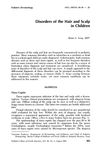Pityriasis Amiantacea: A Clinical and Histopathological Investigation
June 1977
in “
Clinical and experimental dermatology
”
TLDR Pityriasis amiantacea is likely linked to eczema-related skin changes.
In 1977, a study described the clinical findings of pityriasis amiantacea, a localized scaly scalp disease that leads to temporary hair loss, in 71 patients. Biopsies from 18 of these patients revealed that eczematous changes were the most significant feature of the condition. This suggests that the underlying pathology of pityriasis amiantacea may be related to eczematous skin changes.




